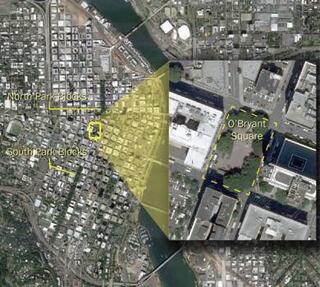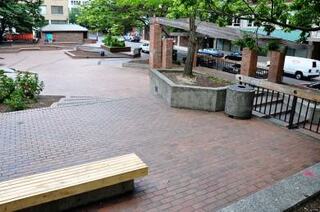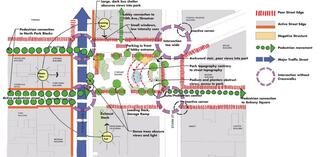Can a Broken Urban Park Be Fixed? Portland’s O’Bryant Square: Part 1
Nestled in the core of downtown Portland, Oregon sits a tired city park called O’Bryant Square. With a checkered history and an uncertain future, we’re going to take a look at this infamous piece of the Portland cityscape in a three part series to address the looming question:
What would it take to “fix” this broken urban park?
The History
Originally dedicated in 1973, after displacing a quarter-block building and surface parking lot, O’Bryant Square represented a mid-town addition to the storied Portland Park Blocks. Unique among the city grid, these park blocks were designed to be half as wide as Portland’s comparatively small 200 ft city blocks and were intended to run the full length of the downtown district as a series of consecutive public spaces.

Due to some 19th century drama involving the original land donor, litigation by his heirs, and resulting city politics, several of the would-be park blocks immediately south of Burnside Street were “lost” to private development, effectively ending the continuity once envisioned. Various efforts to recapture those lost blocks have been launched over the decades, and at the time of its opening, O’Bryant Square represented the latest success in connecting the original intent. And yet, situated a full six blocks north of the other South Park Blocks and two and half blocks south of the [North Park Blocks](https://www.portland.gov/parks/north-park-blocks (which are further separated by Burnside as a major arterial), O’Bryant long existed as an island in the cityscape rather than a continuation of the park series. (The 2009 opening of Director Parkhas only somewhat mitigated O’Bryant’s “island” status.)

In the early 1970s, a $1.25 million investment produced O’Bryant’s unique hardscape design consisting primarily of mortared bricks that still exists today, as well as a below-grade parking garage with a 90-car capacity. Somewhat perplexing given the derision that would eventually follow, O’Bryant garnered a national design award from the U.S. Department of Housing & Urban Development in 1976. The subsequent decades introduced a number of factors that have whittled away at the park’s status in the community, the most obvious of which has been the concentration of homeless congregants and illegal drug activity that have earned the park the widely-used nickname, “Needle Park.”
The Challenges
To best identify the elements that went sour on O’Bryant Square, let’s first consider what makes an excellent and enduring city park. The Trust for Public Land’s Seven Measures of an Excellent City Park System [.pdf] provides a reasonable collection of points to walk through:
1. A clear expression of purpose
As we’ve already described, the original purpose for the park (to progress the effort of reconnecting the Park Block series) was debatably ill-conceived, especially given its poor relationship to surrounding uses.
2. An ongoing planning & community involvement process
With regard to ongoing planning, to the City’s credit, there has been a steady stream of discussions & studies surrounding a “re-do” of the park’s design (a number of which have involved SERA (or our staff), and we’ll describe these in more depth in Part 2 of this series).
3. Sufficient assets in land, staffing, & equipment
When it comes to sufficient park assets, land, and staffing, Portland is certainly no slouch.
Yet, as we get to measures 4, 5, and 6 on the TPL list, O’Bryant’s weaknesses are amplified.
4. Equitable access
5. User satisfaction
6. Safety from crime & physical hazards
Herein lies the crux of the issue: the interaction between a city park and its immediate surroundings dictates how useful, sustainable, and safe it will ultimately be. The diagram below shows that O’Bryant’s integration in the daily flow of the city has been hindered by poor street edges on three of the four sides, awkward pedestrian access from all angles, and obscured visibility.

This final measure raises an interesting element to consider…
7. Benefits for the city beyond the boundaries of the park
O’Bryant has found a serendipitous way to address this aspect, and it just might be its saving grace: it functions as the unofficial dining room of the largest concentration of food carts in Portland.
And it is this surprising development that we will explore further in the final part of our series.
